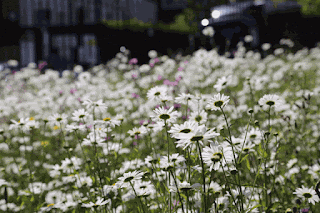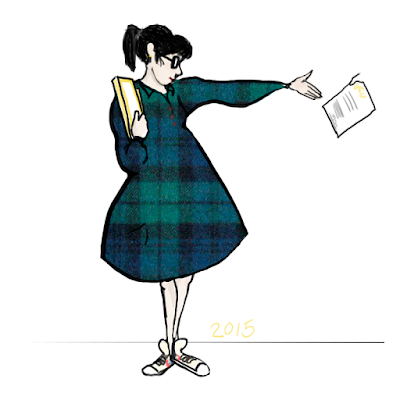I'm realizing that for all my unabashed gushing this past year, I have yet to sit down and actually talk about SIGGRAPH 2015.
As
Molly,
Max, and
Alana can tell you, I never freaking shut up about SIGGRAPH (and the last few months were particularly bad... sorry y'all). For the uninitiated, SIGGRAPH is "the name of the annual
conference on
computer graphics (CG) convened by the
ACM SIGGRAPH organization." In a nutshell, it's the yearly convergence and showcase of the best art, technology, engineering, and computing accomplishments of the last year. It's a maelstrom of wonderful, geeky things.
If you're interested in learning about what went down at this year's SIGGRAPH, you can enjoy the
official conference recaps and the
copious number of technical reviews. They're hugely informative and fun to watch/read. However, conference content is not what I'm gonna be talking about in this post.
 |
| The whole 2015 SV team (+ blazing heat) |
This year, I served as Communications Lead for the Student Volunteer Subcommittee (SVSC for short) for the SIGGRAPH Student Volunteer Program. I accepted this position in October of 2014, and along with it a 2-year commitment to serve the Program at both the 2015 and 2016 conferences. Getting this job was a huge long-shot to my mind, and I'm still bouncing off the walls at the fact that I get to do it.
I found out about SIGGRAPH my junior year of undergrad (2013), and after applying, getting accepted, and serving for an insanely awesome week, I was hooked on the experience. However, by that time I was a year shy of being ineligible for the program completely. I volunteered again as a Team Leader at the 2014 conference, pretty much accepting that this might be it. I didn't anticipate
making the jump from volunteer to subcommittee member but am happy to report that it's been nothing short of a fantastic full-steam learning experience with some of the best people I know. I'm so happy I get to repeat it all this coming year as Marketing Lead and generate some evergreen deliverables that can serve the program for future volunteers and committees.
Beyond that, who knows what my involvement with the Student Volunteer Program will be. Some people have told me what it should be... but for now I'm taking things one conference at a time. Fingers crossed.
</ life story >
So. SIGGRAPH 2015.
 |
| Ashley (aka AshToDaMAX) and me, basically summing up what we do all week. Over and out! |
The Student Volunteer Program essentially serves as the bulk of (if not complete) operational support for the conference. These students are the ones checking badges, manning doors, tallying room counts, delivering supplies, assisting contributors, demoing new technologies, answering attendee questions, solving bizarre problems, monitoring illegal recording -- you name it, a volunteer probably does it. Our volunteer force came in at a whopping 374 Student Volunteers -- tack on an additional 21 Team Leaders, 6 Subcommittee members, and a handful of awesome helpful SV alumni and you have about 400 folks making up the entire team.
SIGGRAPH took place at the
Los Angeles Convention Center -- a 720,000 square foot facility that would house ev.ery.thing. It's the job of the SV Program to make sure every area is appropriately staffed. No small task.
 |
| The Los Angeles Convention Center |
To date, this is the largest volunteer force I've ever worked with on a project/event, and being in a higher-level management position was both daunting and exhilarating. Being relatively new (there are some 5+ year veterans in the program, giving you an idea of how dedicated folks can be), I tend to feel like a greenhorn and hope the sounds coming out of my mouth aren't totally naive. This year, we were gifted with an extremely capable and self-motivated group of volunteers... and I largely credit their performance with helping me fill out my boots. The amount of uncomfortable conflict-resolution I thought I might do was considerably less than I imagined (but then again, I'm a
serial overthinker).
But before I get too self-deprecating, I have to say that despite some loneliness here and there, being a leader feels really cool. I know this post is devolving into another gush-fest but hear me out. It could be a personality thing, but being in an environment that's energetic and fast-paced and busy and your ~#1 BIG JOB~ is to help others... it's like, the most addictive feeling to me. There's always a job to be done, always a question to be answered, always another opportunity to do something that could make somebody's day. Being one of the folks that people come to specifically for that purpose feels really gratifying. OK, the more I write about it, the more I see the ego behind this... Let me sum it up by saying helping others is cool, it feels good, it boosts your self-esteem, everyone should get into it.
 |
| Business in the front, party in the back; Team Leaders and us, the SVSC. |
The conference itself ran from August 9 -13, and it went by really fast. Operationally, SIGGRAPH 2015 went off without a hitch. There were no major malfunctions, no huge logistical mishaps, no full-stop issues, and no (dare I say it over walkie-talke?) emergencies. This is pretty unheard of. I and the rest of the SVSC have to credit Christine Holmes, the 2015 Program Chair, for this. I've met very few people as dedicated, thorough, considerate as Christine, and it was through her efforts that so much of our jobs were made easier. I'm so honored I got to work on her team.
Our Team Leaders performed amazingly, too, and by the end of the week we were floored to see how closely that group of 21 had bonded with each other. I'll always feel a little bit like a matchmaker knowing how Team Leaders were selected, and it's actually an amazing feeling to know that your careful considerations of applications led to a specially-crafted team with a pretty remarkable balance of personalities and work styles. Everyone leaves SIGGRAPH feeling a little more grown, but this is especially true for Team Leaders. I was really happy to see that after a 60-hour week of individual struggles and learning-curves, this group was emerging stronger and more confident than when they walked in.
I'll also take a minute to mention those not involved with the Student Volunteer Program who were essential to its success: Cindy, Paul, Mandie, and Marcia in Conference Management, Peter and Sam from Security, Marc Barr the Conference Chair were - are - all awesome advocates for the work the Student Volunteer Program hopes to accomplish. On-site, they gave us support in an environment where it's common for people to regard Student Volunteers as
just students -- and not the asset they truly are. During the craziness of the conference, it's easy to get stuck in the microcosm of the Program and forget all the hard work and effort that comes from the outside. They'll always remind me to look beyond my workload and appreciate the big picture.
 |
| Sam, myself, Fahad and Peter. Peter and Sam are the most hilarious security personnel you will EVER meet. EVER. |
 |
| Took a minute to cheese with some fellow VCU Rams in the SV Photobooth |
Apart from the day to day hard work and operations, SIGGRAPH also involves a lot of partying, hard drinking, dancing, laughing, sleep deprivation, and general great times with friends you only get to see once a year. As you can imagine, returning to ALT Lab after 10 days of this was hard. There's no denying that volunteering at SIGGRAPH is a huge emotional high, and lots of folks feel a similar come down when they return to "normal" life.
Now that I've had some time to process the experience, I'm realizing more than ever that attitude is so integral to accomplishing good work. Imagine a world where every work week is approached with the same enthusiasm and drive as a 5-day conference -- what would get done? Or better, what
wouldn't get done? If we treated our colleagues like they were only here for a week, how would that affect team morale? What would that level of output look like? Not saying that maintaining a high level of enthusiasm every day is sustainable, but what reason is there to not at least start each day out with a similar feeling?
A lot of people describe coming to SIGGRAPH as a yearly refueling -- it reinvigorates the creative spirit and inspires folks to tackle the goals they might've been hesitant to go after before. I find this to be more and more true each year. This year's conference has given me clearer direction both professionally and personally, as it usually does. This conference, along with every other, is an experience I'll keep close to my heart.
Here's to next year, Anaheim!
E




































